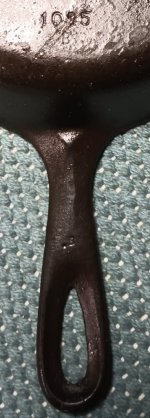DougSahady
New member
Hi All, I appreciate the help I’ve received on this forum in years past, I’m not a collector, but I appreciate and like to use vintage cast iron pans for a lot of my cooking, so I pick one up every now and then when one presents itself. The other day my wife was at a local junk shop and noticed a really crusty WagnerWare Sidney O #5 skillet on one of the shelves. She bought it for me for $13. It cleaned up really nice. I know from what I read that this trademark was used from the 1920s to 1950s. The skillet also has the 1055 pattern number with a letter B. When I cleaned the skillet I found another very small letter B and what appears to maybe be a peen mark next to it on the bottom of the handle. See pic below. This is something that I hadn’t noticed before. Is it common, or could it help maybe narrow the date of manufacture a little? I’m just curious because I’m a history buff and enjoy knowing the approximate date something was made and 1920s through 50s is a little broad. Thanks as always for any feedback.

